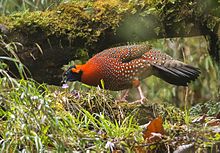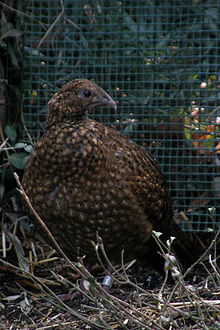Our website is made possible by displaying online advertisements to our visitors.
Please consider supporting us by disabling your ad blocker.
Satyr tragopan
| Satyr tragopan | |
|---|---|

| |
| Male | |

| |
| Female | |
| Scientific classification | |
| Domain: | Eukaryota |
| Kingdom: | Animalia |
| Phylum: | Chordata |
| Class: | Aves |
| Order: | Galliformes |
| Family: | Phasianidae |
| Genus: | Tragopan |
| Species: | T. satyra
|
| Binomial name | |
| Tragopan satyra | |
| Synonyms | |
|
Meleagris satyra Linnaeus, 1758 | |
The satyr tragopan (Tragopan satyra) also known as the crimson horned pheasant, is a pheasant found in the Himalayan reaches of India, Tibet, Nepal and Bhutan. They reside in moist oak and rhododendron forests with dense undergrowth and bamboo clumps. They range from 2400 to 4200 meters in summer and 1800 meters in winter. The male is about 70 cm long.
When it is mating season, male satyr tragopans grow blue horns and a gular wattle. When ready to display, they will inflate their horns and hide behind a rock, waiting for females to pass by. When one does, they will perform an elaborate display in front of the females. At the end of the display, the male will stretch to his full height and show off all of his ornaments.[2]
Females are brown. Males are usually red with blue, black, and white spots and freckles.
Although the least threatened of the tragopans, satyr tragopans still face many threats. The species is thought to have a moderately small population that is subject to hunting and habitat loss throughout most of its range.[3]
- ^ BirdLife International (2016). "Tragopan satyra". IUCN Red List of Threatened Species. 2016: e.T22679157A92804874. doi:10.2305/IUCN.UK.2016-3.RLTS.T22679157A92804874.en. Retrieved 12 November 2021.
- ^ Smith, C. Barnby (1912). "The display of the Satyr Tragopan Pheasant, Ceriornis satyra". Avicultural Magazine. 3 (6): 153–155.
- ^ "Satyr Tragopan (Tragopan satyra) - BirdLife species factsheet". Birdlife.org. Retrieved 30 June 2018.
Previous Page Next Page



